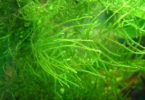Last Updated on February 15, 2023 by Jakob
Growing plants in an aquarium can be a complex process that requires careful attention to several factors. Growing healthy plants is even harder, including lighting, nutrients, water quality, and maintenance. Here are some steps you can follow to help ensure your plants grow strong and healthy in your aquarium so you can learn how to grow plants in an aquarium.
IN THIS ARTICLE
1. Create a base suitable environment:
Aquarium plants need light, carbon dioxide, and nutrients to grow. Make sure your aquarium has a suitable light source, such as a fluorescent or LED light, and add a source of carbon dioxide, such as a CO2 diffuser or yeast reactor, if necessary.
2. Choose the right plants:
Choose plants that are well-suited to aquarium conditions and that are appropriate for the size of your aquarium. Consider the lighting requirements of each plant, and make sure they are compatible with the type of light you have. Some plants, such as Java Fern and Anubias, are well-suited to aquarium conditions and are relatively easy to care for. Other plants, such as stem plants, require more light and nutrients to grow.
3. Use a nutrient-rich substrate:
Plants need nutrients to grow, and a nutrient-rich substrate can provide a steady source of nutrients for the plants. Choose a substrate that is specifically formulated for aquarium plants. A suitable substrate, such as aquarium soil or gravel, is important for plant growth. The substrate should be at least 2 inches deep and rich in nutrients to support plant roots.
4. Lighting:
Plants require a specific amount and quality of light to grow. Depending on the type of plants you choose, you may need to invest in a specialized lighting system that provides the right spectrum and intensity of light. Most aquarium plants require a moderate to high level of light to grow. Make sure your aquarium is equipped with a suitable light source that provides the right spectrum and intensity of light for your plants.
5. Nutrients:
Plants require a variety of nutrients to grow, including nitrogen, phosphorus, potassium, and trace elements. You may need to supplement the nutrients in your aquarium with fertilizers or a nutrient-rich substrate.
6. Fertilize regularly:
In addition to a nutrient-rich substrate, consider using a liquid fertilizer to supplement the nutrients in your aquarium. Follow the manufacturer’s instructions carefully to avoid over-fertilizing, which can be harmful to the plants and fish. You can add a fertilizer designed for aquarium plants to the water or use root tabs to provide the plants with the nutrients they need.
7. Water quality:
Plants are sensitive to changes in water quality, and poor water quality can stunt their growth or cause them to die. You will need to maintain good water quality by testing the water regularly, doing regular water changes, and using a good-quality water conditioner. This includes monitoring pH, temperature, and nitrite levels, as well as doing regular water changes to keep the water fresh.
8. CO2 levels:
Carbon dioxide is an essential nutrient for plants, and some species require higher levels of CO2 than others. Carbon dioxide (CO2) is an important nutrient for plants and is often a limiting factor in aquariums. You may need to supplement the CO2 levels in your aquarium using a CO2 diffuser or other equipment, so genuinely consider supplementing your tank with CO2 to help promote healthy plant growth.
9. Algae:
Algae growth can be a common problem in aquariums with plants. Algae can compete with the plants for nutrients and light, and can also release toxins into the water. You may need to take steps to prevent or control algae growth, such as limiting the amount of light your aquarium receives or using an algae-control product.
10. Maintenance:
Growing plants in an aquarium requires regular maintenance, including pruning and trimming the plants, removing dead leaves or stems, and monitoring the water quality. Neglecting these tasks can lead to problems with plant growth and water quality
11. Prune and trim regularly:
Regular pruning and trimming can help to promote healthy plant growth and prevent plants from becoming overgrown and competing for resources. Remove any dead or decaying leaves or stems promptly to prevent them from releasing harmful substances into the water.
12.Plant the seeds or cuttings:
You can plant seeds or cuttings directly in the substrate or place them in a special plant basket filled with substrate. Make sure the plants are securely anchored in the substrate so they won’t float around in the water.
By following these steps, you can help ensure that your plants grow strong and healthy in your aquarium. Regular maintenance and attention to the needs of your plants can help them thrive and create a beautiful and natural environment for your fish
Despite these challenges, growing plants in an aquarium can be a rewarding and beautiful experience. With proper care and attention, you can create a vibrant and healthy ecosystem that benefits both your plants and your fish.
Benefits of Plants:
There are several benefits to having plants in an aquarium. Here are some of them:
- Aesthetics: Aquarium plants can enhance the overall appearance of an aquarium and make it more visually appealing. Plants come in a variety of colors, sizes, and shapes, which can create a beautiful and natural-looking environment for your fish.
- Oxygenation: During photosynthesis, plants release oxygen into the water, which can benefit the fish and other aquatic organisms in the tank. This process can help improve the overall water quality and reduce stress on fish.
- Nutrient balance: Plants can help to maintain a healthy nutrient balance in the aquarium by absorbing excess nutrients, such as ammonia and nitrates, from the water. This can help prevent algae growth and maintain a stable ecosystem.
- Natural filtration: Aquatic plants can act as a natural filtration system, absorbing toxins and harmful chemicals from the water. They can also help to regulate pH levels in the aquarium, which can benefit the fish and other organisms in the tank.
- Hiding places: Some fish and invertebrates like to hide in plants, which can provide them with a sense of security and help to reduce stress. Plants can also serve as a spawning site for some species of fish.
Overall, having plants in an aquarium can create a healthier and more natural environment for your fish and other aquatic creatures. They can help to improve water quality, reduce stress, and enhance the visual appeal of the tank.
How to grow plants in aquarium with bad water?
Growing plants in an aquarium with bad water can be challenging, but it is not impossible. Here are some steps you can take to help your plants grow in a less-than-ideal water environment:
- Use a good-quality water conditioner: If your tap water contains high levels of chlorine or other harmful chemicals, it can harm your plants. Use a good-quality water conditioner that can neutralize these chemicals and make the water safer for your plants.
- Test the water regularly: Testing the water regularly can help you identify any issues that may be affecting your plants. You can test for pH levels, ammonia, nitrite, and nitrate levels, which can all impact plant growth.
- Use a nutrient-rich substrate: A nutrient-rich substrate can help provide your plants with the necessary nutrients to grow, even if the water is not ideal. Choose a substrate that is specifically formulated for aquarium plants.
- Choose hardy plants: Some plants are more tolerant of poor water quality than others. Choose hardy plants that can withstand fluctuations in pH and nutrient levels. Examples of hardy plants include java fern, anubias, and mosses.
- Limit light exposure: If you are struggling with algae growth, you may need to limit the amount of light your aquarium receives. Algae thrive on light, and limiting the exposure can help prevent algae from taking over and competing with your plants for resources.
- Perform regular maintenance: Regular maintenance is essential to keep your plants healthy in an aquarium with bad water. Remove any dead or decaying leaves or stems promptly, and perform regular water changes to maintain good water quality.
By following these steps on how to grow plants in aquarium, you can help your plants grow in an aquarium with bad water. Although it may be more challenging, with proper care and attention, you can create a healthy and vibrant environment for your plants and your fish.







